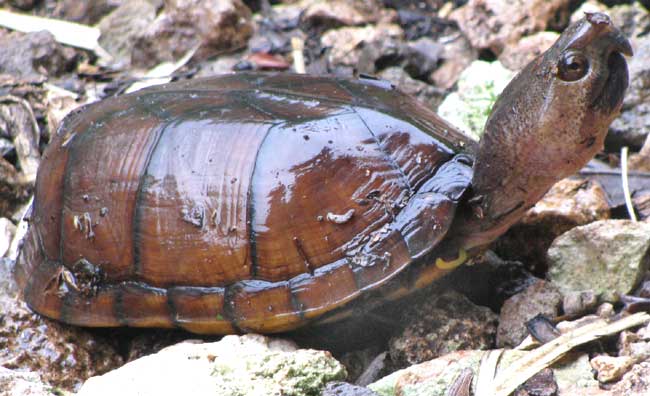Excerpts from Jim Conrad's
Naturalist Newsletter

from the July 11,, 2010 Newsletter issued from Hacienda Chichen Resort beside Chichén Itzá Ruins, central Yucatán, MÉXICO; limestone bedrock, elevation ~39m (~128ft), ~N18.52°, ~W95.15°
MUD TURTLE
The Yucatán is a vast, low slab of limestone. Over great periods of time rainwater dissolves limestone so the Yucatán's bedrock is honeycombed with caves and other erosional fissures. In some places caves have collapsed causing sinkholes to form on the surface. Here sinkholes are called cenotes (se-NO-tehs). In the arid north and somewhat less arid central Yucatán, rainwater is drained away by subterranean rivers. In fact, except where sinkholes are deep enough to dip below the groundwater level, forming circular, very swimmable pools, in the Yucatán's interior there are no rivers, streams, lakes or ponds.
Therefore, imagine my delight the other day when as I sat in my hut's door watching the end of an afternoon rainstorm a Creaser's Mud Turtle, KINOSTERNON CREASERI, wandered right in front of me. It's shown above.
This is a narrowly endemic species restricted to the northern and central portions of the Yucatán Peninsula in the states of Yucatán, Quintana Roo, and Campeche, Mexico. It's smallish, and beyond its dark color, two good field marks seem to be the the way the back of the top shell, or carapace, is suddenly flattened, instead of being gradually sloped like the front, plus the mouth's top mandible is hooked as shown.
Creaser's Mud Turtle specializes in drier habitats, which is a bit unusual for a mud turtle. Apparently little is known about it, except that you're likely to see it after rains, and during the rest of the long dry season probably lies dormant beneath layers of debris in the forest.
What a pleasure to meet such an uncommonly encountered species right outside my door!